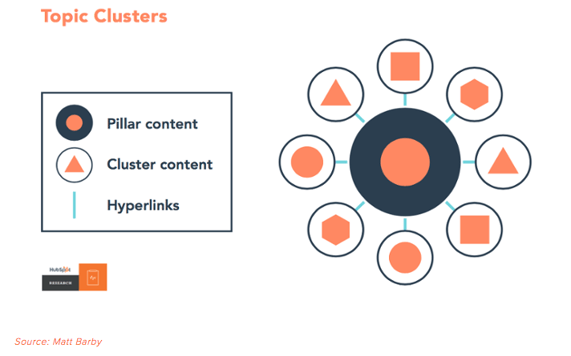93% of online experiences begin with a search engine. Still, some companies aren’t convinced that...
If You've Never Heard of Topic Clusters, You're Missing the Mark in SEO

Search engines have been forcing marketers to adapt their content strategies for years. Just when marketers think they've cracked the SEO code, search engines change the type of content they want to see in order to highly rank websites.
Today, many marketing teams share the same pain points when it comes to their site ranking and content or SEO strategies, such as:
- Our attention to keyword research doesn't seem to be paying off.
- We have great content, but we still don't have a competitive ranking in Google.
- It's tough to measure the ROI from the content we create.
In an effort to resolve these issues, marketing teams get caught up in the cycle of feeding the content beast until he's chock-full of repurposed, recycled and redundant information.
But generating large volumes of content that are equally underperforming won't lead to a better ranking. In fact, it may hurt your chances of being recognized by Google whatsoever. Having a poor site architecture that's flooded with underwhelming content is just as problematic as having no content at all.
The answer to this problem can be found in the way content strategies are developed and organized.
In a recent study by Hubspot, the latest trend in content marketing appears to be the use of topic clusters to drive SEO.
The study claims that topic clusters are the latest evolution of SEO, and other reports have called topic clusters "the new keywords."
So, what exactly are these topic clusters, and should we really care? In other words, are topic clusters just another passing fad in content marketing?
First, let's take a look at the driving forces behind this new model for optimizing content.
Why the Change?
Now that search engines are using new algorithms and software for web crawling and site ranking, many companies are facing a harsh reality. Traditional SEO strategies that worked before to improve page ranking – such as utilizing different buzzworthy long-tail keywords – are a thing of the past.
There are two crucial factors driving this shift in SEO effectiveness:

-
The way we search has changed
-
Since 2008, voice search queries have increased 35 times over. Now that search engines can understand our questions, one in every five Google searches in 2016 was a voice search from a mobile device. This trend has continued to increase year by year and can be attributed to Google’s leading algorithm, Hummingbird. When Google integrated Hummingbird a few years ago, the way we search underwent a complete overhaul. Now, algorithms focus on analyzing full sentences and conversational phrases instead of matching keywords directly. For example, voicing the query, “Where can I get the cheapest oil change?” returns a customized map of your local area, catering to your car needs. Your local oil change didn’t need to write a blog post titled, “Where You Can Get the Cheapest Oil Change” to rank – Hummingbird just understood what you needed and granted it.
-
-
The algorithms have become more sophisticated
-
Before, Google ranked content by its keyword relevancy. Today, Google filters and ranks content by the material’s In 2015, Google enhanced its search algorithms by adding a new machine-learning component called Rankbrain. Over the last few years, Rankbrain has grown increasingly sophisticated in how it filters content and has tested endless amounts of searches to gain this knowledge. When a consumer performs a Google search, their query is filtered through a machine-learning interpretation that includes factors like the consumer’s past behavior while searching and their current location. Rankbrain then presents a response that aligns more closely with the consumer’s true intent, which leads to an even more accurate, specific and advanced search result. As a consequence, your marketing team’s clever long-tail keywords are rendered futile.
-
Since search engines now return queries based on abstract concepts, synonyms and natural language, marketers must shift their focus to becoming the most relevant content resource—not solely focusing on keywords. And one way of doing so is by integrating the effective solution of using topic clusters.

How Clusters Strengthen Topic Authority
In the simplest of terms, a topic cluster is a way of grouping content related to a central topic. A topic cluster contains a core topic, or “pillar page,” which other content pages are organized around. The content pages then internally link to the pillar page, and also to one another.
A pillar page must be broad in nature and rich in information, including keywords and industry language. For example, a pillar page topic could be “digital marketing,” and the content pages – which cover more detailed, individualistic topics – would include things like “SEO strategy,” “content calendar,” “blogging,” and “digital ads.”
Each subtopic content page should effectively expand in more detail on a specific keyword or industry-related term found in the pillar page. This way, one high-performing cluster can elevate your ranking, along with all of the rankings for content pages linked to that same pillar.
This creates a better strategy behind the content produced, ultimately boosting authority around a particular topic that your target audiences are searching for. Topic clusters incites deeper coverage of several core topics while simultaneously creating an effective site architecture that search engines will crawl.
Furthermore, constructing a solid information architecture is essential to ranking in organic searches with today’s algorithms—especially if you want to rank for broad topics. Focusing on hyper-relevant content will solve this issue while allowing you to create pages that your audiences actually want to read. It will also result in higher efficiency for your site’s SEO and save you from wasting time on creating useless content.

Creating Your First Topic Cluster
If you’re ready to give topic clusters a go, you should first question whether or not this strategy is the best approach for your particular website. Ask your team:
- Does the topic idea or pillar page we want to rank for have enough search volume to be worth the effort?
- Have we already created content that covers the topic idea?
- Is the topic idea something we want to cover in more detail?
After you’ve worked through these questions and your answers all point to “yes,” you are in a great position to start forming your first topic cluster.
When you begin to map out your topic cluster, you’ll want to begin with your pillar page. What are the five key problems your buyer personas typically have? Gather these problems into broad topic areas, and select one of the topics to be your first pillar.
As you focus on your pillar page – such as “content marketing” – you will want to perform some keyword research to build out your subtopics and new content pages. Each new content page should align with the pillar page, which will allow for internal linking later on.
Validate your ideas with competitive and industry-standard research. Finally, you can begin to create your new content around your central topic, measure its traffic and lead generation and refine your strategy as time goes on.
While this is a simplistic overview, it can assist the process of structuring your content calendar based on your new topic cluster. Eventually, you will be able to measure which topics earned you the most leads and which earned the most engagement, coverage or backlinks.
As you turn toward topic clusters to enhance your content marketing efforts, don’t forget that search engines are incredibly smart—and getting smarter every day. They don’t care if you are creating content designed specifically for their crawlers; rather, they like content that consumers want to see.
In most cases, you don’t even need to mention a keyword in your copy for search engines to understand that it’s relevant to your target audiences.
Shifting your strategy to content that involves topic clusters will result in your team creating high-performing content, improving your SEO and search engine visibility and offering an overall better experience for your site visitors.




